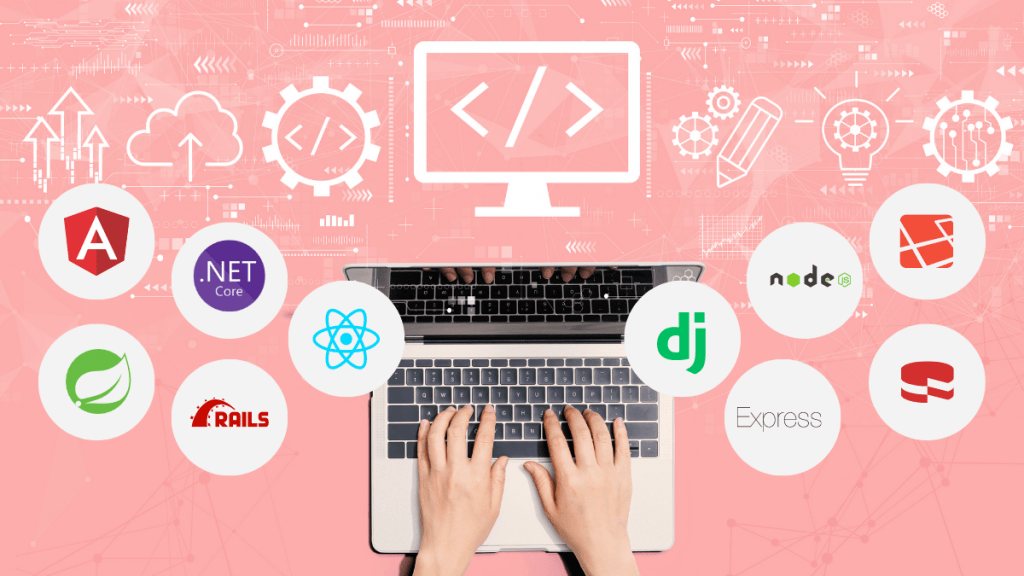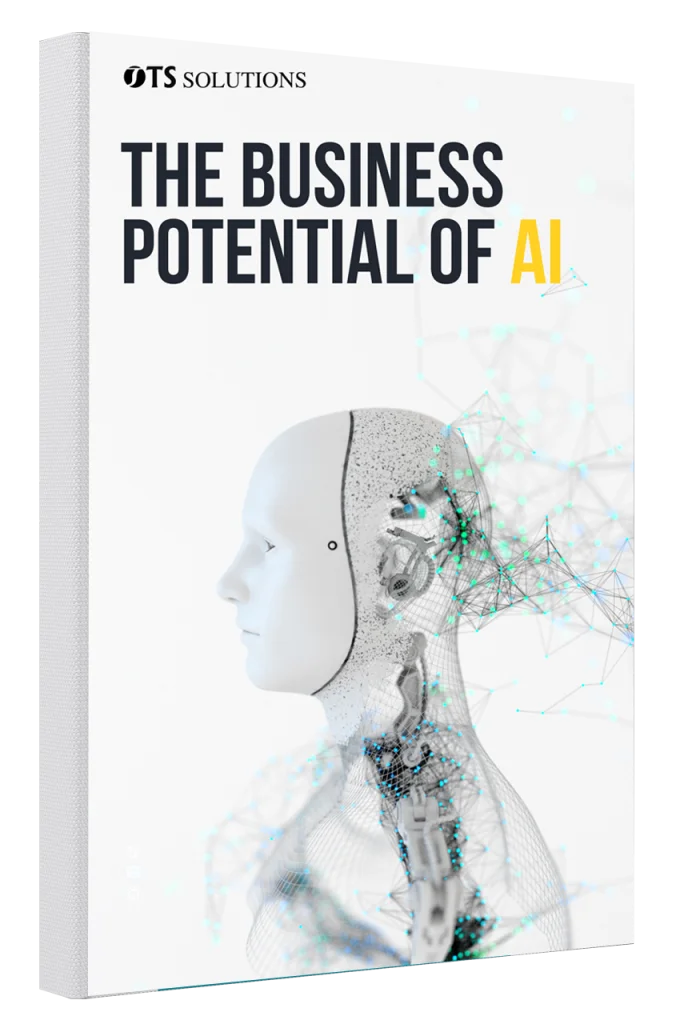Top 10 Frameworks for Developing Enterprise Applications
Enterprise application development projects have been transforming all industries such as healthcare, education, travel, hospitality, etc. Experts predicted that the framework-based application development market can grow by $527.40 billion by 2030.
In this blog, we discuss the top-rated enterprise application development frameworks that make your process of developing an enterprise application easy.
What are Enterprise Applications?
Enterprise Applications are software systems that have been designed to help organizations or businesses manage and automate their day-to-day processes. These applications help to streamline different business activities by integrating various activities and processes such as accounting, human resources, and inventory management.
Enterprise applications can also provide valuable insights into different operations to help businesses make data-driven decisions. They are often customized to suit the specific needs of a company and are essential for the effective management of large organizations. Overall, enterprise applications play crucial roles in the operations of modern businesses, helping to promote efficiency, and productivity at all organizational levels.
Examples of Enterprise Applications
Enterprise applications refer to software programs designed to cater to the specific needs of businesses and organizations. These applications are used to manage and streamline various business processes and operations, including customer relationship management, enterprise resource planning, enterprise resources planning, supply chain management, human resource management, and business intelligence and analytics. Advancements in technology and the need for efficient applications have become an essential part of modern-day businesses.
Market Growth of Different Types of Enterprise Applications:
| Growth Rate CAGR (Compound Annual Growth Rate) in % | Type of Enterprise Application |
|---|---|
| 13.9% | CRM |
| 6.2% | ERP |
| 10.9% | SCM |
| 12.8% | HRM |
| 9.1% | BI |
Importance of Enterprise Applications
Enterprise applications are essential for modern organizations. They help companies improve efficiency and productivity, reduce costs, and enhance customer satisfaction. They provide organizations with a competitive edge by enabling them to respond to market trends and customer needs quickly. Enterprise applications can help organizations manage their workforce, financials, supply chain, customer relationships, and more.
Also Read: The Importance of Security and Compliance in Enterprise Applications
Top 10 Most Popular Frameworks for Enterprise Applications
1. Angular.js
Angular JS is a robust and flexible framework for building large and complex web applications. It is maintained by Google and provides a range of features, such as data binding, dependency injection, and testing.
Key features of Angular JS
It is also highly modular, allowing developers to easily integrate third-party libraries, which can help to simplify the development process. AngularJS is also highly flexible, allowing developers to create custom directives, services, and filters to meet their specific needs. Furthermore, it comes with a built-in set of tools and features, such as two-way data binding, dependency injection, and routing, that make it a popular choice for building modern web applications. Overall, AngularJS is a robust and feature-rich framework that helps developers to create powerful web applications with ease.
2. React.js
React.js is one of the best frameworks for enterprise applications maintained by Facebook and used for building interactive user interfaces. It is known for its high performance and flexibility, making it ideal for large-scale applications.
Key features of React JS
One feature of React is an extension that allows developers to write HTML-like code in JavaScript. This makes it easier to write and understand code and helps to prevent common errors that can occur when mixing HTML and JavaScript code. Other features of React include its virtual DOM (Document Object Model) implementation, which allows for fast and efficient rendering of components, and react native app development company support for server-side rendering, which improves the performance of web applications.
3. Spring Framework
Spring framework is an open-source and widely used enterprise framework for building Java applications. It provides a range of features, such as dependency injection, aspect-oriented programming, and declarative transaction management.
Key features of Spring Framework
Spring Framework provides robust support for web development, including features like data binding and validation, and seamless integration with popular web frameworks like Java Server Faces and Struts. The Spring Framework also includes support for messaging and integration with enterprise service buses like Apache Camel, making it an excellent choice for developing large-scale enterprise applications with complex data and communication flows.
4. Ruby on Rails
Spring framework also includes modules for application development such as security, data access, and messaging, making it a versatile and powerful tool for developers. It is lightweight nature, modularity, and ease of use make the spring framework a highly preferred choice for building complex and scalable enterprise applications.
Ruby on Rails is a web application development framework for the Ruby programming language. It emphasized convection over configuration and provides a range of features, such as an ORM (Object Relational Mapper), routing, and middleware.
Key features of Ruby on Rails
Some of the key features of Ruby on Rails include its Model-View-Controller (MVC) architecture, which separates the application logic from the user interface, making it easier to manage complex applications. Another notable feature is the use of convention over configuration (CoC), which reduces the amount of code needed by providing default settings for many common configurations. Additionally, Ruby on Rails includes a wide range of libraries and tools, including tools for database management, testing, and deployment, which further simplifies the development process. These features have made Ruby on Rails a popular choice for web developers who want to build scalable and maintainable web applications.
5. ASP.NET Core
ASP.NET Core is an open-source and cross-application. It is maintained by Microsoft and provides a range of features, such as dependency injection, Razor view engine, and middleware. ASP.NET is the best framework for front-end web development.
Key features of ASP.NET Core
It provides an extensive set of libraries, tools, and APIs (Application Programming Interfaces) that simplify the development process. Additionally, it offers cross-platform support with built-in security features such as authorization and authentication, that help to protect web applications from cyber-attacks.
6. Express.js
Express.js is a popular framework for building web applications with Node.js. It provides a simple and minimalist approach to building web applications RESTful API (Application Programming Interfaces) and real-time applications.
Key features of Express JS
Its features include routing, middleware, templating engines, error handling, and debugging tools. Express.js also supports a range of HTTP methods such as GET, POST, PUT, and DELETE, which makes it easier to interact with databases and APIs. Additionally, Express.js is highly modular and can be easily customized with third-party packages.
7. Django
Django is a high-level Python web framework that emphasizes rapid development and clean, pragmatic design. It provides a range of features, such as ORM, middleware, and authentication.
Key features of Django
Some of the key features of Django include a power ORM for database management, a built-in admin interface for site management, robust tools for handling authentication and security, built-in support for multiple languages, and the ability to handle asynchronous programming with ease. Additionally, Django’s modular design allows developers to easily incorporate existing libraries and applications, which simplifies the development process.
8. Laravel
Laravel is a popular PHP web framework that emphasizes elegance and simplicity. It provides a range of features, such as an ORM, routing, and authentication.
Key features of Laravel
Its feature consists of ORM (Object Relational Mapping) which allows developers to easily work with databases. Laravel also supports migration, and the latest version has integrated support for scheduling jobs, broadcasting events, and notifications. The framework provides a testing tool, and it also allows developers to easily set up a local development environment with Homestead. With these features, Laravel provides developers with a great platform to build complex web applications with clean and maintainable code.
9. Node.js
Node.js is an open-source and cross-platform framework for building scalable and high-performance applications. It provides a range of features, such as an event-driven architecture, asynchronous I/O, and a module system.
Key features of Node.js
Node.js also has a rich library of modules, which enables developers to create complex applications with minimal effort. Another feature that sets Node.js apart from other server-side frameworks is its event-driven architecture, which allows developers to write asynchronous code and handle numerous client requests without running out of resources. Additionally, Node.js has an active community that creates and maintains a range of useful tools, modules, and packages, making it a popular choice for web developers.
10. CakePHP
CakePHP is a popular PHP web framework that comes next in our frameworks list known for its simplicity and ease of use. It provides a range of features, such as an ORM, caching, and security.
Key features of CakePHP
This allows developers to create scalable and maintainable web applications with minimal coding efforts. CakePHP also provides built-in support for data validation, security, and caching, making it a robust choice for building complex web applications. Additionally, CakePHP offers easy integration with other libraries and frameworks, making it a versatile and flexible option for web development. Overall, the features of CakePHP make it a powerful tool for developers to create robust web applications with ease.
Also Read: How Custom Apps Can Help Enterprises Grow? A Comprehensive Guide
How to Choose the Right Framework for Your Enterprise Application Development?
Frameworks significantly reduce the time and effort required to develop enterprise applications. By providing pre-built components and libraries, developers can focus on building application-specific functionality rather than writing and testing.
1. Understanding the business requirements
The first step is to identify what the application is meant to achieve. Then knowing the target audience for the application is important in deciding on the user interface and user experience design. Understanding the target audience will help determine the appropriate framework to use. After that analyzing the business domain and processes that involve an understanding of how the application fits into the overall business strategy must be determined.
2. Evaluate the Technology Stack
Once you understand the business requirements, the next step is to evaluate the technology stack. This involves determining the programming language, and runtime environment, identifying the data storage and retrieval mechanisms, and analyzing the integration and communication requirements.
3. Scalability and Performance Needs
Scalability and performance are critical factors in ensuring that the application can handle large amounts of traffic and user load. This involves evaluating the expected user load and traffic, determining the resource utilization and optimization strategies, and analyzing the caching and load balancing requirements.
4. Consider the development team’s expertise.
It is important to consider the expertise of the development team. This involves assessing the team’s skill set and knowledge, determining the training and support needs, and analyzing the team’s experience with similar projects.
5. Full-Stack frameworks
A full-stack enterprise application development framework refers to a set of tools, libraries, and technologies that provide a comprehensive solution to building complex business applications. The objective of such frameworks is to simplify the development process by offering a layered architecture that segregates the backend and frontend functionalities, while also providing development tools for both. These frameworks are designed to handle a wide range of enterprise application development tasks such as data management, security, scalability, and performance optimization. Typically, these frameworks are comprised of several components such as database connectors, API builders, web frameworks, and user interface libraries, which can be customized to suit the developer’s needs.
6. Microservices frameworks
Microservices frameworks for enterprise development encompass a set of software tools, libraries, and platforms that facilitate the creation, deployment, and maintenance of microservices-based applications. These frameworks enable developers to divide complex components into independent modules that can be easily broken down, updated, and scaled as required. The microservices architecture provides many benefits, including improved flexibility, agility, and scalability, and enhanced fault tolerance and maintainability. Popular frameworks such as Spring Boot, Dropwizard, and Micronaut provide pre-built features and components to streamline microservice development, making it easier for organizations to adopt this modern architecture and take advantage of its benefits.
7. No-code/low-code frameworks.
No/low code enterprise application development frameworks provide a simplified approach to designing sophisticated software applications without the need for extensive coding skills. Such frameworks enable users to rapidly build, test and deploy applications within a fraction of the time it would take using traditional software development methods. They provide a visually enabled interface that allows users to easily drag and drop pre-built components and data integration points to create custom applications. With these frameworks, companies can leverage their resources efficiently, drive innovation, and respond to business changes quickly and effectively. These frameworks continue to gain popularity as organizations recognize their potential to cut development costs, reduce time-to-market, and increase operational efficiency, all leading to a more efficient and streamlined business environment.
8. Cloud-based frameworks
Cloud-based frameworks refer to software development tools and platforms that enable developers to build and deploy applications on cloud infrastructure. They help develop applications on cloud infrastructure. They help deploy software applications quickly and efficiently by providing a flexible and scalable environment for deployment. These frameworks are hosted on cloud servers such as Amazon Web services, Microsoft Azure, and Google Cloud Platform, providing a reliable infrastructure to run applications. Cloud-based frameworks have become increasingly popular in recent years as they offer significant benefits such as cost savings, easy maintenance, and the ability to automate tasks. They are also ideal for businesses looking to scale and grow, as they offer a flexible and scalable architecture that can accommodate changing demands.
Comparing Frameworks:
When comparing frameworks, it is important to evaluate their performance, scalability, and security. Performance refers to how quickly the application responds to user requests. Scalability refers to the ability to handle increasing levels of traffic or data. Security refers to protecting the application and user data from malicious attacks.
1. Cost-Benefit Analysis of Framework Selection
Selecting the right framework involves a cost-benefit analysis, considering factors such as the time and resources required for development, the scalability and maintenance of the application, and the potential return on investment.
2. Determining Framework Suitability for Your Enterprise Application
The suitability of a framework for an enterprise application depends on factors such as the application’s requirements, the development team’s expertise, and the organization’s technology stack. By considering these factors and carefully evaluating popular frameworks, organizations can select the best framework for their enterprise application.
3. Assessing the scalability and sustainability of the framework
One of the key factors to consider when selecting a framework for your enterprise application is scalability and sustainability. It is important to choose a framework that can handle growth and can be maintained over the long term.
Also, Read: The Complete Guide To Developing Enterprise Applications For Any Business
Conclusion:
The choice of framework for enterprise application development is a crucial decision that can impact the success of your project. By understanding the criteria for choosing a framework, comparing their features, performance, and scalability, and considering their advantages and disadvantages, you can make an informed decision and select the right framework for your enterprise application development project.
In this blog, we discussed the top 10 frameworks for enterprise web development in detail. You can select one of these application frameworks to develop the next enterprise application.
To know more, contact us to discuss more about our custom enterprise software development solutions.
Frequently Asked Questions
1. What are the most popular enterprise application development frameworks?
The most popular enterprise application development includes Customer Relationship Management (CRM), Supply Chain Management (SCM), Enterprise Resource Planning (ERP), Human Resource Management (HRM), Business Intelligence (BI), and Content Management Systems (CMS).
2. What factors should be considered when selecting an enterprise application development framework?
You must consider a few important points when selecting a framework:
- The framework must be well-suited to the specific needs and requirements of the business, including size, resources, and goals.
- The framework should be flexible and easily customizable, allowing for easy integration.
- The cost and licensing requirements of the framework must be carefully evaluated to ensure it fits within the budget and resources of the business.
3. Can enterprise application development frameworks be customized to meet specific needs?
Frameworks are an essential aspect of enterprise app development, and they help in streamlining the entire development process. However, the real benefit of using a framework is its customizability. By modifying the existing codebase or adding new functionalities, developers can tailor the framework to meet their specific needs. This allows them to create an application that not only meets the distinctive requirements but also boosts productivity and reduces costs.
4. How are top software development frameworks used in enterprise software development?
Frameworks are essential in enterprise software development as they provide developers with a structured and standardized approach to coding, allowing them to focus on the business logic rather than the underlying technology. These frameworks often come with pre-built components and libraries. Developers use these components to integrate into the application, which speeds up the development process and results in a more efficient and scalable application.
5. What are enterprise application frameworks?
An enterprise application framework is a set of tools and techniques used to develop, maintain, and scale applications in a complex organization. It provides a standard structure for developers to build high-quality applications. Developers can integrate it with other systems and technologies used across the enterprise. The framework includes libraries, modules, and APIs that speed up development and ensure consistency in the application design and functionality.








